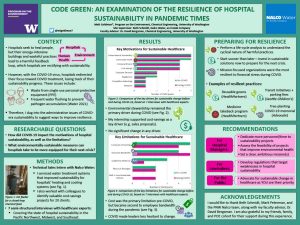Code Green: An Examination of The Resilience of Hospital Sustainability in Pandemic Times
Hospitals are recognized as centers for healing the human population, but their energy-intensive and wasteful operations harm the environment, which inevitably harms humans that will need to seek care at these hospitals. With the pandemic, this unsustainable cycle only worsened as many hospitals shifted their focus and funding toward COVID-19 treatment. In this study, I sought to paint a picture of the state of hospital sustainability prior to and during the COVID-19 pandemic to assess its resilience in a time of crisis. As a technical sales intern with Nalco Water, I serviced various water treatment processes that aimed to improve hospital sustainability and minimize risk, while also collaborating with representatives to identify valuable cost-savings projects for 20 clients. Additionally, I conducted seven interviews with healthcare experts to understand any changes in sustainability resilience from the pandemic. From these methods, I learned that environmental stewardship remained at the forefront of hospitals’ mindsets, followed by community health and cost-savings. However, major revenue losses continued to act as the primary limitation for sustainable development, along with reduced employee bandwidth. Based on these findings, hospital leaders should pursue life cycle assessments to understand the cyclical nature of their harmful activities. Lawmakers can also use these trends to inform the development of regulations that target weaknesses in hospital sustainability. With this knowledge and guidance, hospitals will be better equipped to pursue sustainable solutions that enhance hospital resilience, preparing them to survive in future crises sooner than later.
